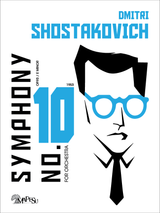
The symphony is a short (about 20 minutes) experimental work in one movement; within this movement are four sections, the last of which includes a chorus. In a marked departure from his First Symphony, Shostakovich composed his Second in a gestural, geometric "music without emotional structure" manner, with the intent of reflecting speech patterns and physical movements in a neo-realistic style. This choice may have been influenced at least partially by Vsevolod Meyerhold's theory of biomechanics.
Shostakovich placed far more emphasis on texture in this work than he did on thematic material. He quickly adds sonorities and layers of sound in a manner akin to Abstract Expressionism instead of focusing on contrapuntal clarity. While much of the symphony consequently consists of sound effects rather than music, the work possesses an unquestionable vitality and incorporates the basic elements of the musical language he used in the rest of his career.
The Second Symphony was commissioned to include a poem by Alexander Bezymensky, which glorified Lenin's role in the proletariat struggle in bombastic style. The cult of Lenin, imposed from the upper echelons of the Party, grew to gigantic proportions in the years immediately following his death. The work was initially titled "To October". It was referred to as a Symphonic Poem and Symphonic Dedication to October. It became To October, a Symphonic Dedication when the work was published in 1927. It only became known as a "symphony" considerably later.
- Difficulty:
- Intermediate/Advanced
- Instrumentation:
- Picc, 2Fl, 2Ob, 2Cl, 2Bsn, 4Hn, 3Tpt, 3Tbn, Tba, Timp, Perc, SATB Choir, Strings
- Duration:
- ca 20 minutes
- Set of Parts:
- Includes Strings count 4.4.3.3.2
- Extra Strings:
- Only available with the purchase of the Set of Parts






